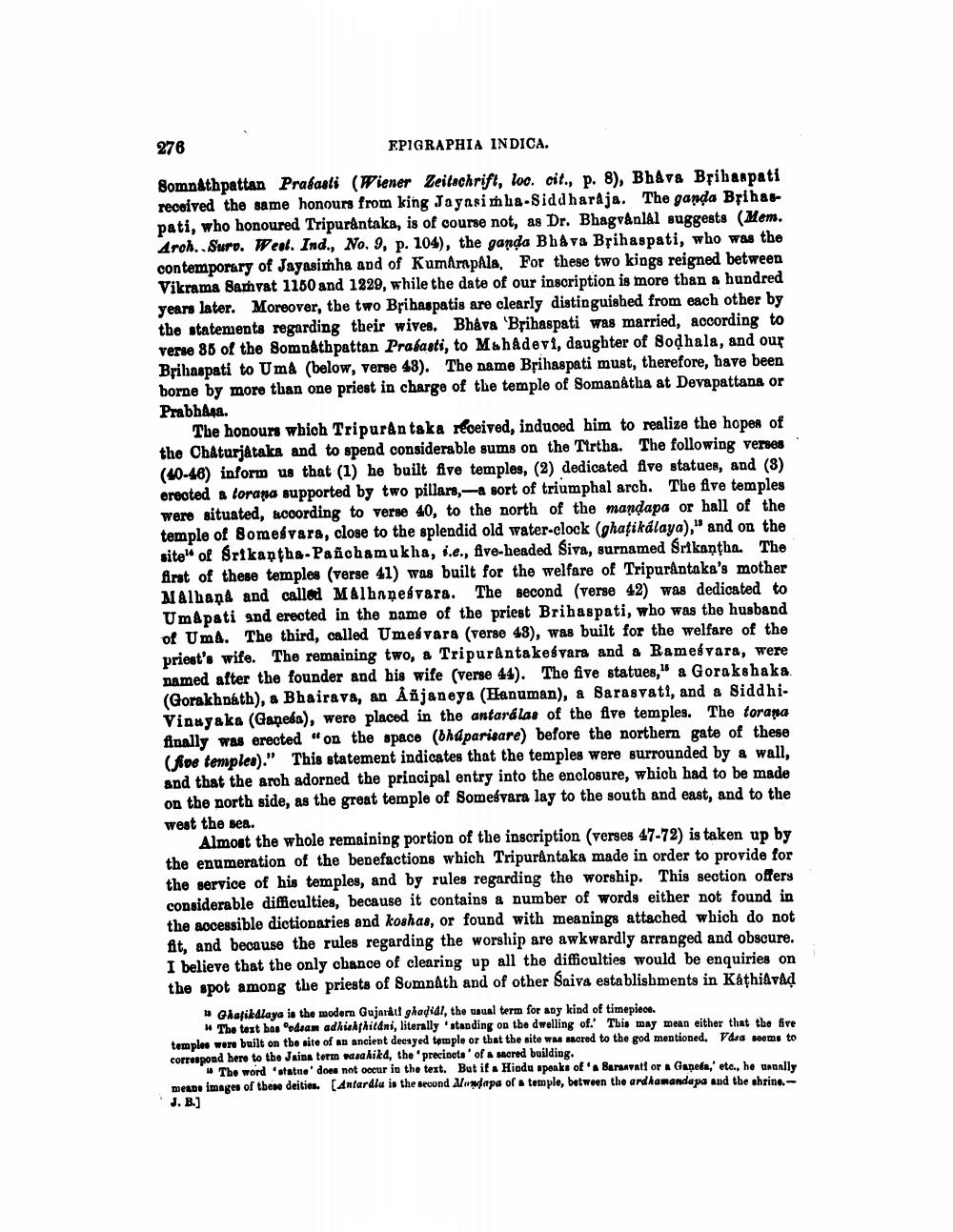________________
276
EPIGRAPHIA INDICA.
Somnathpattan Prasasti (Wiener Zeitschrift, loc. cit., p. 8), Bhava Bțihanpati received the same honours from king Jayasimha-Siddhardja. The ganda Brihaspati, who honoured Tripurantaka, is of course not, as Dr. Bhagvanlal suggests (Mem. Aroh. Suro. Weal. Ind., No. 9, p. 104), the ganda Bhava Brihaspati, who was the contemporary of Jayasimha and of Kumarapala. For these two kings reigned between Vikrama Samvat 1150 and 1229, while the date of our inscription is more than a hundred years later. Moreover, the two Bribaspatis are clearly distinguished from each other by the statements regarding their wives. Bháva 'Brihaspati was married, according to verse 86 of the Somnathpattan Prasasti, to Mahadevi, daughter of Sodhala, and our Brihaspati to Um& (below, verse 43). The name Bțihaspati must, therefore, have been borne by more than one priest in charge of the temple of Somanåtha at Devapattana or PrabhA98.
The honour which Tripuran taka received, induced him to realize the hopes of the Chaturjátaka and to spend considerable sums on the Tirtha. The following verses (40-46) inform us that (1) he built five temples, (2) dedicated five statues, and (3) erected a torana supported by two pillars,-a sort of triumphal arch. The five temples were situated, according to verse 40, to the north of the mandapa or hall of the temple of someśvara, close to the splendid old water-clock (ghatikálaya)," and on the site of Srikantha-Pañchamukha, 1.e., five-headed Siva, surnamed Srikantha. The first of these temples (verse 41) was built for the welfare of Tripurantaka's mother MAlhand and called M&lhnnesvars. The second (verse 42) was dedicated to Umapati and erected in the name of the priest Brihaspati, who was the husband of Uma. The third, called Umeśvara (verse 48), was built for the welfare of the priest's wife. The remaining two, a Tripurantakeśvara and a Ramešvara, were named after the founder and his wife (verse 44). The five statues," a Gorakshaka (Gorakhpath), a Bhairava, an Anjaneya (Hanuman), a Sarasvati, and a SiddhiVinayaka (Ganesa), were placed in the antará las of the five temples. The torana finally was erected "on the space (Bhdparisare) before the northern gate of these (ive templeo)." This statement indicates that the temples were surrounded by a wall. and that the arch adorned the principal entry into the enclosure, which had to be made on the north side, as the great temple of Somesvara lay to the south and east, and to the west the sea.
Almost the whole remaining portion of the inscription (verses 47-72) is taken up by the enumeration of the benefactions which Tripurantaka made in order to provide for the service of his temples, and by rules regarding the worship. This section offers considerable difficulties, because it contains & number of words either not found in the accessible dictionaries and koshas, or found with meanings attached which do not fit, and because the rules regarding the worship are awkwardly arranged and obscure. I believe that the only chance of clearing up all the difficulties would be enquiries on the spot among the priests of Somnath and of other Saiva establishments in Kathiavad
Gharibdlaya is the modern Gujarki ghadidl, the usual term for any kind of timepiece.
# The text bas odaam adhishthildni, literally 'standing on the dwelling of. This may mean either that the fire temples were built on the site of an ancient decayed temple or that the site was sacred to the god mentioned. Vara seme to correspond here to the Jaina term wasahikd, the precincts' of a sored building.
The word 'statne does not occur in the text. But if Hindu spanks of 'BATAVAt or a Gapela, etc., he canally means images of these deities. [Antardla is the second Mondapa of a temple, between the ardhanandapo and the shrine.
J. B.)




